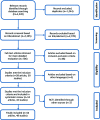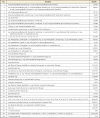Effectiveness of Manual Therapy and Therapeutic Exercise for Temporomandibular Disorders: Systematic Review and Meta-Analysis
- PMID: 26294683
- PMCID: PMC4706597
- DOI: 10.2522/ptj.20140548
Effectiveness of Manual Therapy and Therapeutic Exercise for Temporomandibular Disorders: Systematic Review and Meta-Analysis
Abstract
Background: Manual therapy (MT) and exercise have been extensively used to treat people with musculoskeletal conditions such as temporomandibular disorders (TMD). The evidence regarding their effectiveness provided by early systematic reviews is outdated.
Purpose: The aim of this study was to summarize evidence from and evaluate the methodological quality of randomized controlled trials that examined the effectiveness of MT and therapeutic exercise interventions compared with other active interventions or standard care for treatment of TMD.
Data sources: Electronic data searches of 6 databases were performed, in addition to a manual search.
Study selection: Randomized controlled trials involving adults with TMD that compared any type of MT intervention (eg, mobilization, manipulation) or exercise therapy with a placebo intervention, controlled comparison intervention, or standard care were included. The main outcomes of this systematic review were pain, range of motion, and oral function. Forty-eight studies met the inclusion criteria and were analyzed.
Data extraction: Data were extracted in duplicate on specific study characteristics.
Data synthesis: The overall evidence for this systematic review was considered low. The trials included in this review had unclear or high risk of bias. Thus, the evidence was generally downgraded based on assessments of risk of bias. Most of the effect sizes were low to moderate, with no clear indication of superiority of exercises versus other conservative treatments for TMD. However, MT alone or in combination with exercises at the jaw or cervical level showed promising effects.
Limitations: Quality of the evidence and heterogeneity of the studies were limitations of the study.
Conclusions: No high-quality evidence was found, indicating that there is great uncertainty about the effectiveness of exercise and MT for treatment of TMD.
© 2016 American Physical Therapy Association.
Figures





References
-
- McNeill C. Epidemiology. In: McNeill C, ed. Temporomandibular Disorders: Guidelines for Classification, Assessment, and Management. 2nd ed Chicago, IL: Quintessence Publishing Co; 1993:19–22.
-
- Di Fabio RP. Physical therapy for patients with TMD: a descriptive study of treatment, disability, and health status. J Orofac Pain. 1998;12:124–135. - PubMed
-
- Gremillion HA. The prevalence and etiology of temporomandibular disorders and orofacial pain. Tex Dent J. 2000;117:30–39. - PubMed
-
- de Wijer A, de Leeuw JR, Steenks MH, Bosman F. Temporomandibular and cervical spine disorders: self-reported signs and symptoms. Spine (Phila Pa 1976). 1996;21:1638–1646. - PubMed
-
- Kritsineli M, Shim YS. Malocclusion, body posture, and temporomandibular disorder in children with primary and mixed dentition. J Clin Pediatr Dent. 1992;16:86–93. - PubMed
Publication types
MeSH terms
Grants and funding
LinkOut - more resources
Full Text Sources
Other Literature Sources
Medical
Miscellaneous

